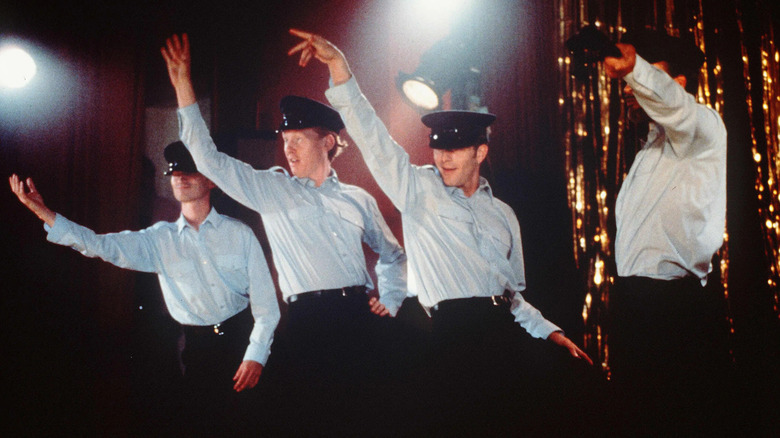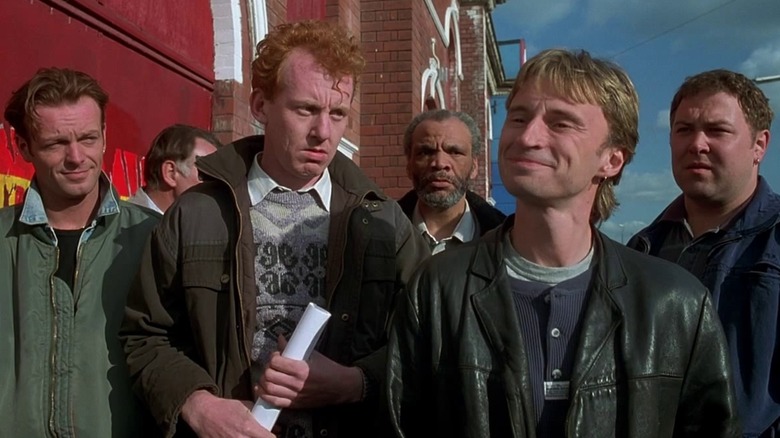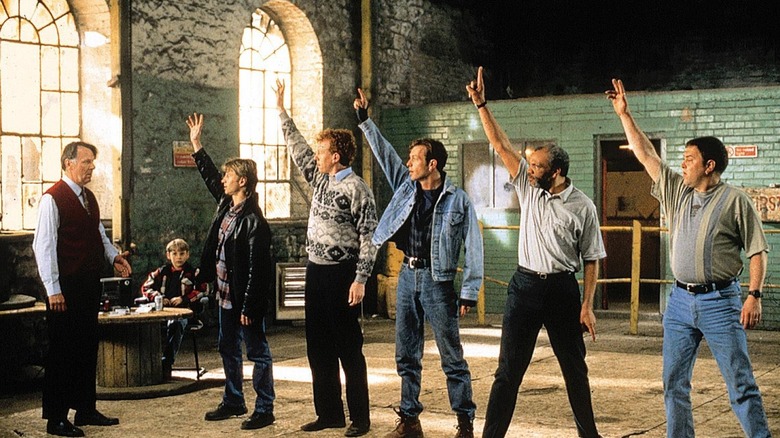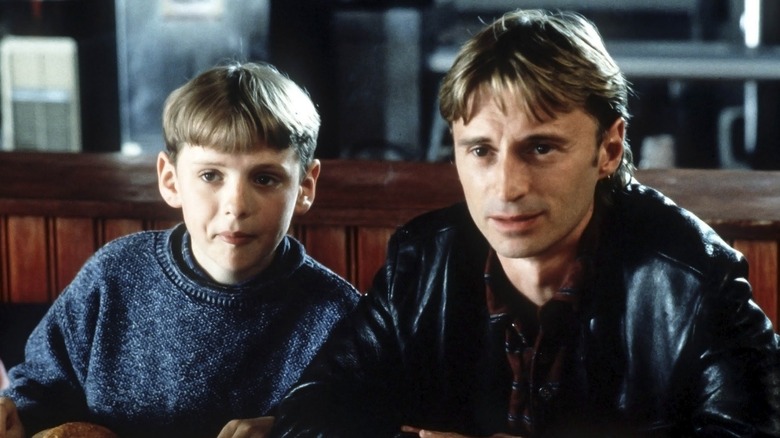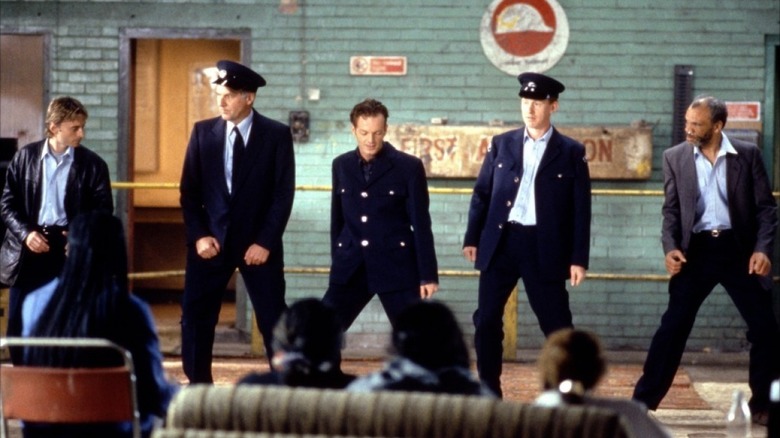The Full Monty At 25: The Underdog Story That Took On Titanic At The Oscars
When "The Full Monty" came out in the UK in 1997, it surprised just about everybody. There wasn't much buzz around my way, and most people seemed to think it was some kind of raunchy comedy for women. In those less enlightened times, I fielded several questions regarding my sexual orientation when I told friends I was going to see it. Some just couldn't understand why a straight guy wanted to watch a film about blokes getting their kit off.
Word-of-mouth built quickly and the screening I attended was packed. The crowd was roughly 70% women and the atmosphere was raucous, like a hen party getting revved up for the night. They were restless at first, probably because the film isn't a joke-a-minute comedy and it takes a while to get into the stripping action. Then the gang started their bumbling rehearsals and the tunes started, and the women were absolutely howling. All the guys were howling, too, and it quickly became obvious that "The Full Monty" wasn't a raunchy comedy for women at all; it was a very human comedy for all of us.
"The Full Monty" was one of those films where I went in expecting very little but came out with a big stupid grin on my face and an extra buoyancy in my step. I've seen many comedies at the cinema which brought the house down, but few have done it by creating such a sense of togetherness. It was so moving and funny and, for all its feel-good vibes, touched upon real struggles many of us regular folk face in our day-to-day lives. No wonder the whole country took it to their hearts, and within a year, it was facing off against the big boys at the Oscars.
So what happens in The Full Monty again?
25 years after Sheffield, UK, was a booming steel town, many of the mills have closed and two former steelworkers, Gaz (Robert Carlyle) and Dave (Mark Addy), are struggling to make ends meet after losing their jobs. Dave suffers from low self-esteem due to his weight and Gaz is desperate for cash because his ex-wife, fed up with him missing child support payments, is seeking sole custody of their son.
After a disastrous attempt to steal some scrap metal, they spot a group of eager women queuing up outside a Chippendales-style strip show. Sneaking inside to see the crowd's wild reaction to the strippers, Gaz decides to put on his own show offering the women real blokes instead ... blokes like him and Dave. He plans to outdo the well-oiled pros by going the full monty — that is, strip stark bollock naked.
First onboard is Lomper (Steve Huison), a depressed former security guard who lives at home with his mum, followed by Gerald (Tom Wilkinson), their old foreman who still hasn't told his wife that he's unemployed. Holding auditions for the remaining slots, they also bring in Horse (Paul Barber), an aging guy with a dodgy hip who can still bust some moves, and Guy (Hugo Speering), who can't dance but is well-endowed in the "lunchbox" department.
Disaster strikes during a rehearsal in front of Horse's female relatives when a policeman busts them for indecent exposure. Social services get involved and Gaz is prevented from seeing his boy, and Gerald's wife kicks him out of the house. But there's no such thing as bad publicity, and news of their arrest has made the show a sell-out. Now they have the audience, will they have the balls to go through with it?
How did The Full Monty come about?
Screenwriter Simon Beaufoy, who spent time living in Sheffield, was trying to sell a script about a group of Yorkshire men who paint pylons for a living. "Among Giants" wasn't greenlit (until after "The Full Monty" was a smash) but it caught the attention of producer Uberto Pasolini. Beaufoy recalled in an interview:
"We had a chat about a two-or-three page outline about guys in a gym, and there were two or three lines about The Chippendales, and he said, 'That's interesting.' And I went, 'No, it's old news, a bit tacky. Why's that interesting?' He said, 'In Italy, this would never happen. What has happened to British men that they would humiliate themselves by taking their clothes off in front of women for money?' And I thought, 'Oh, that is interesting!' And that's how it started."
Beaufoy took that thread and wrote the screenplay, which found its way to director Peter Cattaneo when Pasolini met him at a film festival. Cattaneo remembered:
"He said, 'I've got this script ... don't panic, it's about male strippers, but it's much better than it sounds.' My whole thing was just to get the laughs right but try to play it as a story, as a drama, and not really force the gags at all, just let that come out of the situations. But it had stuff ... like the dole queue scene ... I put a massive tick by it when I read it, but you kind of think, 'Will that ever quite come off?' But the actors just embodied it so much it worked."
It worked, all right; the "Hot Stuff" dole queue scene became so popular that even Prince Charles got in on the action, recreating the scene during a visit to Sheffield.
How does The Full Monty hold up?
"The Full Monty" is very much a film of its time, but its central themes are just as relevant today, especially in Britain where many families are struggling with soaring energy prices and the cost of living crisis. It came along at the tail-end of Cool Britannia and the start of Tony Blair's New Labour regime, two events that gave the nation renewed energy and optimism after almost two decades of the Conservative government. While Britain felt like it was on the move, "The Full Monty," for all its crowd-pleasing vibes, was actually an astute piece of social realism that offered a gentle reminder that there were still whole communities, especially in the north, still suffering the ill effects of Thatcherism from a decade before.
In between the tunes, awkward rehearsals, and dance routines, the film plays like one of Ken Loach's lighter, funnier ones. It is less about stripping and more about a group of men doing what they can to make ends meet, more "Raining Stones" than "Magic Mike." There are genuine moments of kitchen sink tragicomedy and despair: Take Dave almost accidentally assisting Lomper's suicide attempt or Gerald's desperate meltdown after the boys wreck a potentially face-saving job interview for him. Beaufoy explained:
"Humor in the north of England is a coping strategy, it's a way of dealing with pain. You can tell a story tragically, or you can laugh about it. And it's just as tragic, but you've got a room full of people laughing with you."
It's these moments of bleak humor, delivered note-perfect by the excellent cast, that gives "The Full Monty" real resonance that still plays well today.
Going The Full Monty on set
Life on the dole is no life at all. I only spent four months unemployed back in the UK and it's grim; I can see how it could seriously knock your self-respect over a longer period. This is really key to the film's underdog appeal, because going "The Full Monty" takes plenty of confidence and courage for anyone, even with a "Magic Mike" body. For our guys, it's a way of taking control of their situation, putting some cash in their pockets, and winning back a little self-esteem. In this respect, the film also offered a body-positive message when body positivity was only just becoming a recognized term, cannily casting a group of actors who looked like regular blokes in the street. How could anyone resist rooting for them?
Stripping the whole way was a daunting prospect for the actors as much as their characters. The six actors involved agreed to only one take when they would actually go naked in front of the crowd for the final scene. The routine, set to "You Can Leave Your Hat On" by Tom Jones, was shot in one day in front of a real audience, many of whom were regular strip show attendees.
The screenplay originally ended with the guys performing a naked star jump, which caused consternation for the cast and a logistical headache for Cattaneo. He knew he couldn't really have the actors' dangly bits flying around all over the place, so how would he pull it off with just one take? He then had a lightbulb moment:
"And then it just struck me... Just do it from behind. Bums are funny, balls are yucky. That little flare of light between Tom Wilkinson's butt cheeks is just like, Cinema God shining down."
The Full Monty vs Titanic
The Cinema God was indeed shining on "The Full Monty." Critics, some clearly shocked by how good it was, raved about the film and it struck a real chord with audiences. As a result, it took a ridiculous $258 million worldwide against its modest $3 million budget (via Box Office Mojo). Come awards season, the low-budget underdog story became the underdog itself, going up against some huge Hollywood movies for the big prizes. Speering said:
"It was nuts, really. There are things you remember like the Golden Globes, the Oscars, and you're sitting at a table next to Jack Nicholson and Kim Basinger and all these people... you see your heroes."
At the Oscars, "The Full Monty" was up against "Titanic," "L.A. Confidential," "As Good as it Gets," and "Good Will Hunting" for Best Picture. In another year it might have pulled off an upset, but "Titanic" crushed all before it, and romped home with 11 awards. Cattaneo was also up for Best Director, but nothing was stopping "King of the World" Cameron that night. A month later, BAFTA voters at least made the fairytale come true by giving it Best Picture, while Carlyle won Best Actor.
"The Full Monty" inspired numerous stage productions and TV shows, which remain popular even 25 years on; how about "The Real Full Monty on Ice," anyone? It has become embedded in British popular culture as much as "The Great Escape" or "Only Fools and Horses," a film we just know in our hearts, and our pelvises. If you don't believe me, go to a disco bar or an oldies night in the UK and see how people react when Donna Summer's "Hot Stuff" comes on.
